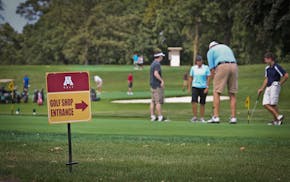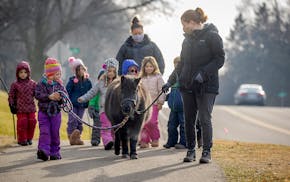For one week this fall, Darci Gabriel spent the first hour of her day scanning the sidewalks of downtown Minneapolis' Mill District for small brown lumps lying still among the fallen leaves. They're bird carcasses, the result of window collisions as migratory birds travel through the Mississippi Flyway en route to their winter destinations.
In the northwest side of the Bridgewater Lofts condominium, Gabriel finds one dainty gray bird with a lime-yellow throat, lying prone with its feet tucked up. She snaps a photo, then logs its location and her best guess at its species — Tennessee warbler — in a Survey123 mobile app that bird lovers use worldwide to track bird vs. building collisions and inform scientific research on bird mortality. Then she scoops the carcass into a Chinese takeout container to donate to the Wildlife Rehabilitation Center in Roseville.
She rounds the corner of Bridgewater Lofts and immediately finds another one.
"Hopefully something can be done, even if it's just having people dimming their lights in the evenings," said Gabriel. "Just having downtown dimmed down would actually help prevent a lot of the migratory birds coming into the city to begin with."
The Mill District, where Gabriel lives, has undergone heavy development in the last 20 years, with high-rise condos displacing warehouses and surface parking lots from their prime locations along the Mississippi River. The area is also a migration route, with birds hardwired to follow the open river north and south each spring and fall to avoid mountains and other towering obstacles.
With the built environment of our urban centers rapidly outpacing the evolution of migratory birds, strikes happen because birds don't register glass as solid and impenetrable. When the sun rises and downtown skyscrapers reflect the foliage of the boulevard trees, birds careen into buildings when they think they're aiming for the leafy landscaping, scientists believe.
Collision hot spots
The Audubon Chapter of Minneapolis collected strike data during both spring and fall migrations this year, focusing on hot spots including the U.S. Bank Stadium, residences along the river and downtown skyways. A handful of volunteers working about an hour each morning for a week took in 54 birds, including 43 dead on arrival, three that died from their injuries, three in care and five released after rehab.
"Our approach with building owners and managers is to raise awareness about the magnitude of the effect of window collisions on total bird populations, the impact their building is having and solutions to mitigate that impact," said Jeannine Thiele, vice president of the local Audubon, which advocates for the use of bird-safe glass in new construction and cities' participation in the Lights Out program.
Lights Out, first implemented by the city of Toronto three decades ago, involves coordinated efforts to reduce nonessential lighting in urban centers during key migration periods, when billions of birds are passing overhead. Most of them fly by night, when temperatures are cooler and thus better for long-haul travel, but when they reach city clusters of artificial lights, they can become dazzled and disoriented.
Other cities that have implemented Lights Out include Boston, Chicago, Atlanta and Dallas. In some cases, the changes came only after a critical mass of bird fatalities were connected to certain buildings.
"This is a simple and free, in fact money-saving, measure that building managers can undertake to make a difference," Thiele said.
Audubon has begun to do outreach with building owners to inform them of dead birds near their properties, but has not yet received any responses.
On the first day of monitoring last month, 10 birds were found near U.S. Bank Stadium.
Research and recommendations
In 2019, researchers from Oklahoma State University and the University of Minnesota published a study that found the stadium and three other buildings were responsible for 74.3% of bird collisions found at 21 buildings. The study and others said, big picture, there's no discernible connection between window strike mortality and long-term population trends for species, but collisions with man-made structures are one of the main causes of death of North American birds, with an estimated 1.5 billion killed annually.
The Vikings and stadium owner Minnesota Sports Facilities Authority paid for the study, which recommended treating high-impact portions of the stadium's glassy exterior with patterns that make it visible to birds. The MSFA didn't commit to doing that but has incorporated other recommendations.
"Suggestions related to landscaping and vegetation have been and will continue to be incorporated into landscaping projects," said MSFA spokesperson Lisa Niess. "The MSFA continues to participate in Lights Out program while maintaining safety and security lighting needs, and the lighting requirements of stadium events."
Robert Johnson Miller and his wife, Denise, monitored the stadium for Audubon this year. They love birds. Denise also volunteers in the Wildlife Rehabilitation Center's songbird nursery, while Robert, a construction specifier for the Minneapolis architecture firm HGA, always promotes the use of bird-safe glass.
Still, he acknowledges that many developers aren't keen on spending an extra $20 per square foot on bird-safe glazing, especially on a large project with a lot of windows. Some designers fear it won't look as aesthetically pleasing. He offers examples of bird-safe buildings that HGA has worked on as counterpoint, such as the Westwood Hills Nature Center in St. Louis Park, a net-zero-energy building.
He also encourages single-family homeowners to put bird tape over their windows during migration periods, a relatively affordable way that ordinary people can help.
"The majority of deaths and collisions are actually happening on people's homes," said Robert Johnson Miller. "If you think about how many homes there are in the U.S. versus how many glass high-rises there are, you start to realize that the skyscrapers aren't necessarily the problem, and a lot of the strikes are happening in the first 30 feet from the ground. A lot of strikes happen on residential windows, and when we put bird tape on our windows, that reduces it a lot."

Thompson found guilty of murder in car crash that killed 5 young women

University of Minnesota is putting its golf course up for sale
Supreme Court allows DOGE team to access Social Security systems with data on millions of Americans
Feeding Our Future probe: Apple Valley woman charged with defrauding food program of $1.4 million

